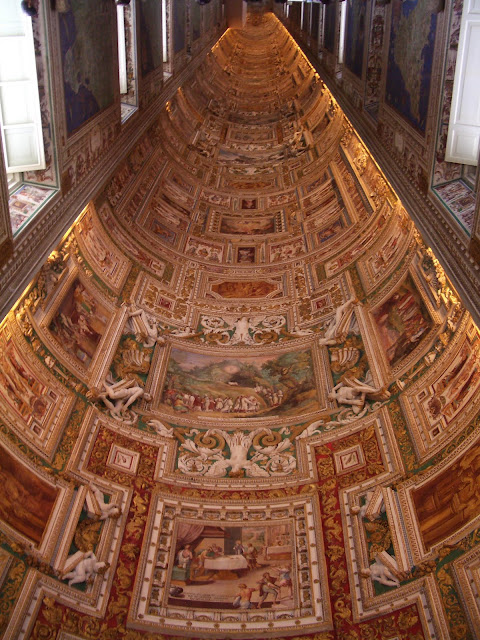This is the Vatican Museum continued. After the Nile Rive statue I continued on through the museum and I got to this internal courtyard. But there's more to see here than is in this picture.
Here are some more statues in this courtyard.

You can see by this alternate view all the statues that line the courtyard. Some of these are the best statues in the Vatican Museum. What else is there?
According to the Internet, "The founding of the Vatican Museums can be traced back to 1503 when the newly- elected Pope, Julius II Della Rovere, placed a statue of Apollo in the internal courtyard of the Belvedere Palace built by Innocent VIII; he brought the statue from the garden of his titular church of st. Peter in Chains. In 1506 the Laocoön was added to the collection, after its discovery on the Esquiline Hill before the eyes of Giuliano da Sangallo and Michelangelo Buonarotti. Scores of artifacts were added throughout the next two centuries and the collections were eventually reorganized under Benedict XIV (1740-1758) and Clement XIII (1758-1769). They founded the Apostolic Library Museums: the Sacred (Museo Sacro - 1756) and the Profane (Museo Profano - 1767) Museum". This statue in particular is, according to the Internet, "One of the major discoveries of the Italian Renaissance, this sculptural grouping was found in Rome in 1506 in the ruins of Titus' palace. It depicts an event in Vergil's Aeneid(Book 2). The Trojan priest Laocoön was strangled by sea snakes, sent by the gods who favored the Greeks, while he was sacrificing at the altar of Neptune. Because Laocoön had tried to warn the Trojan citizens of the danger of bringing in the wooden horse, he incurred the wrath of the gods." Notice that this is the same as found in Versailles in Paris.
There are other statues in the courtyard, like this of the god Tigris and a guard dog.
And then the Museum continued indoors again. This is where all the good stuff is and why are there herds of tourists that I had to walk by on my way to school each day (especially on Monday when the line is the longest). What's here? Let's go and see...
The cielings are a work of art as well, and you always have to look up at every room you go into to see some amazing sites. As I look at my ceiling and walls now, they are all plain white paint and not even the modern art kind, just the kind that comes from no decorating/frescos/fine art on them.

And of course some more statues. There are so many that these are just some of the best ones I took pictures of. I don't know if there is anywhere with more marble statues per foot like the Vatican Museum.
Now onto my favorite room in the Vatican Museum. We've all seen statues of mythical gods and goddesses, but what about our animal friends. Well they have their own room as well. Now as usual my camera was dying of battery almost immediately this whole time so in fact each picture I took I had to plan out exactly and turn my camera on, quickly take it, then turn my camera off again. It was kind of annoying but it helps me get good pictures. But anyways, on to the animal room. These are two slightly different views of the same room. This was the room on the right side and I wasn't able to take a pic of the room on the left side because of my camera.
Here is the statue of the Emperor Galba, which I literally took standing right next to it. He's important.
Now we're getting back to the ceilings. Some of them are pretty amazing considering how they are painted perfectly even on an angle.

Now we are entering the map room. It has maps of all the regions of Italy. But the ceiling frescoes are pretty amazing. This picture is rotated upside down so the frescoes make sense visually.

And here are some of the maps. They all look pretty much the same so I moved pretty quickly through this room.














No comments:
Post a Comment